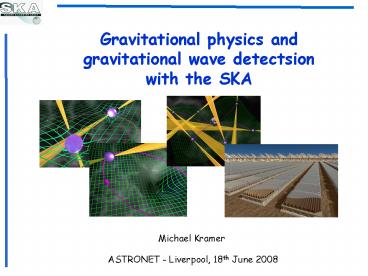Gravitational physics and gravitational wave detectsion with the SKA - PowerPoint PPT Presentation
1 / 11
Title:
Gravitational physics and gravitational wave detectsion with the SKA
Description:
Gravitational physics and gravitational wave detectsion with the SKA – PowerPoint PPT presentation
Number of Views:84
Avg rating:3.0/5.0
Title: Gravitational physics and gravitational wave detectsion with the SKA
1
Gravitational physics andgravitational wave
detectsionwith the SKA
Michael Kramer
ASTRONET - Liverpool, 18th June 2008
2
Gravitational physics with the SKA
SKA will be a superb instrument for fundamental
physics, e.g. - Equation-of-state of
dark energy - Changes of fundamental
constants - Neutrino mass -
Gravitational physics - etc.
Browse the very rich SKA Science Book and
the many updates in the literature Here
- Detection of gravitational waves -
Tests of theories of gravity in strong fields
3
Strong-field tests of gravity
Definition of strong field vs. weak fields (e.g.
Will 2006)
- Simple 1PN approximation is no longer appropriate
- Evolution of the system may be affected by grav
radiation - Highly relativistic orbital motion (vc)
- Orbital motion can have imprints from the
strong-field internal - gravity of the bodies (esp. for alternative
theories)
- Pulsars probe strong-fields
Kramer et al. (2006)
- Already very successfully using binary pulsars
- E.g. Double Pulsar confirms GR at 5x10-4
level - However, more extreme systems exists in the
Galaxy - ? hunt for the
PSR-BH systems!
Kramer et al. (2006)
4
Pulsar Black Hole Systems
- Various types stellar BH, intermediate mass BH
in globular clusters - and pulsars around
super-massive BH in Galactic Centre - Qualitatively different probe for both GR and
alternative theories
Limits on tensor-scalar theories
a binary pulsar with a black-hole companion has
the potential of providing a superb new probe of
relativistic gravity. The discriminating power of
this probe might supersede all its present and
foreseeable competitors (Damour
Esposito-Farese 1998)
Esposito-Farese (2008)
5
Testing Black Hole Properties
- Use pulsar orbit as probe for intrinsic
properties of BHs - Relativistic and classical spin-orbit coupling
as the tool - Applicable to wide range of masses and orbits
- Measurable
Black Hole spin measured via relativistic
SO-coupling, i.e. as wobble
of the orbit (scales with M2)
Black Hole quadrupole moment measured via
classical SO-coupling,
i.e. as transient timing signals (scales with
M3)
- Not easy (needs SKA!), but allows us e.g. to
test GR concepts of BHs - - Cosmic Censorship Conjecture
- i.e. Non-existence of naked
singularities (event horizons!) - - No-Hair theorem
- i.e. Determination of BHs properties by
mass, spin and charge
6
The SKA Sky Revolution
- Galactic Census will yield 30,000 pulsars
1,000 MSPs
- Essentially all pulsars beaming towards Earth
- Sample includes PSR-stellar BH systems as well
as pulsar around SGR A - But also 1000 millisecond pulsars to directly
detect gravitational waves
7
Pulsars as Gravitational Wave Detectors
- Pulsar timing is affected by the displacement of
the pulsar and the Earth due to the presence of
gravitational waves - Hence, pulsars or a combination of them as a
Pulsar Timing Array act as a network of arms
of a huge, sensitive cosmic gravitational wave
detector
- Perturbation in
- space-time can be
- detected in timing
- residuals
- Sensitivity as a
- dimensionless strain
Pulsar Timing Array
8
Pulsars as Gravitational Wave Detectors
(Kramer et al. 2004)
- PTA is sensitive to
- nHz gravitational waves
- as sensitive as LISA
- Complementary to LISA,
- LIGO and CMB-pol band
- Expected sources
- - binary super-massive
- black holes
- - Cosmic strings
- - Cosmological sources
- Types of signals
- - stochastic (multiple)
- - periodic (single)
- - burst (single)
9
Example 1 Single source detection
- Single binary super-massive black hole produces
periodic signal - Signal contains information from two distinct
epochs t and t-d/c - Characteristic signal in timing data
Pulsar timing residuals (cf. Jenet at al. 2006)
10
Example 2 Stochastic background
- Strongest signal expected from binary
super-massive black holes in - early galaxy evolution
- Amplitude depends on merger rate, galaxy
evolution and cosmology - Resulting stochastic background detectable from
displacement of - Earth in correlation of timing residuals with
sky position
- Shape of correlation function
- depends on theory of gravity
- and GW polarization
- Experiment rather difficult
- today but easy with the SKA!!
Figure provided by F. Jenet
11
Summary
- SKA will improve over current PTA experiments by
at least four - orders of magnitude GW science at nHz-range
becomes easy! - For instance
- definite answer on existence of cosmic strings
- stringent limit on graviton mass
- - single source detection likelihood increases
from lt2 (now) to gt90
- Pulsars orbiting BHs can probe their properties
for different masses
- mass, spin and quadrupole moment
- test of cosmic censorship conjecture
- testing no-hair theorem
- unique tests of alternative theories
- Besides unique science, many synergies
- and complementarities to other future
facilities e.g. LISA, XEUS, GAIA































